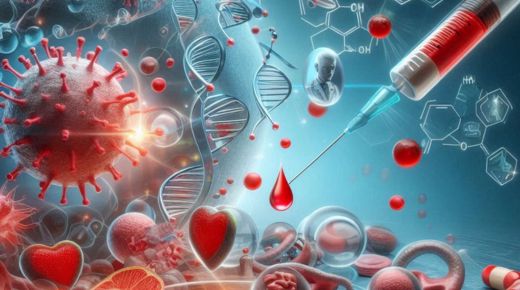In recent years, the landscape of cancer treatment has undergone a dramatic transformation, particularly with the introduction of innovative therapies such as nanomedicines for blood cancers. Blood cancers, including leukemia, lymphoma, and multiple myeloma, present unique challenges due to their systemic nature and the complexity of delivering effective treatments. However, advances in nanotechnology have paved the way for novel approaches that enhance drug delivery, reduce side effects, and improve patient outcomes.
This article explores the role of nanomedicines in treating blood cancers, the mechanisms behind their effectiveness, and the future prospects of this groundbreaking approach.
Understanding Blood Cancers
Blood cancers, also known as hematologic malignancies, affect the production and function of blood cells. They typically originate in the bone marrow, lymphatic system, or blood itself. The most common types of blood cancers include:
- Leukemia: A cancer that leads to the overproduction of abnormal white blood cells, impairing the body’s ability to fight infections.
- Lymphoma: Cancer that starts in the lymphatic system, particularly in lymphocytes (a type of white blood cell). It includes Hodgkin and non-Hodgkin lymphoma.
- Multiple Myeloma: A cancer of plasma cells, which are responsible for producing antibodies. This condition leads to bone damage and weakened immune response.
Challenges in Treating Blood Cancers
Blood cancers pose several treatment challenges, including:
- Systemic Spread: Blood cancers can disseminate rapidly throughout the body, making it difficult to target only the cancerous cells without affecting healthy ones.
- Resistance to Treatment: Cancer cells can develop resistance to chemotherapy and other therapies, leading to treatment failure and relapse.
- Severe Side Effects: Traditional cancer therapies often lead to debilitating side effects, affecting the patient’s quality of life.
The Emergence of Nanomedicines
Nanomedicine refers to the application of nanotechnology in healthcare, utilizing nanoparticles—particles ranging from 1 to 100 nanometers—to improve the diagnosis, treatment, and monitoring of diseases. The unique properties of nanoparticles make them suitable for targeted drug delivery, allowing for enhanced therapeutic effects while minimizing side effects.
Key Features of Nanomedicines
- Targeted Delivery: Nanoparticles can be engineered to bind specifically to cancer cells, ensuring that therapeutic agents are released at the disease site.
- Reduced Toxicity: By focusing on cancer cells and sparing healthy tissues, nanomedicines can reduce the severe side effects associated with conventional therapies.
- Multifunctionality: Nanoparticles can carry multiple therapeutic agents and imaging agents simultaneously, enabling both treatment and monitoring of the disease.
How Nanomedicines Work in Blood Cancer Treatment
Nanomedicines work through several mechanisms that enhance the efficacy of cancer treatment:
1. Targeted Drug Delivery
One of the most significant advancements in nanomedicine is the ability to deliver drugs directly to cancer cells. This is achieved through the functionalization of nanoparticles, where specific ligands or antibodies are attached to their surface. These ligands can recognize and bind to specific receptors overexpressed on cancer cells.
For example, in leukemia treatment, nanoparticles can be designed to target specific antigens present on the surface of leukemic cells, ensuring that chemotherapy drugs are delivered directly where they are needed. This targeted approach increases the drug concentration at the tumor site while minimizing exposure to healthy cells.
2. Combination Therapy
Nanomedicines can carry multiple therapeutic agents, allowing for combination therapy within a single nanoparticle. This is particularly beneficial in blood cancers, where multi-drug regimens are often required to overcome resistance.
For instance, a single nanoparticle could deliver a chemotherapeutic agent alongside a targeted therapy, such as a monoclonal antibody. This approach not only enhances treatment efficacy but also reduces the likelihood of resistance developing.
3. Imaging and Monitoring
Nanomedicines can also incorporate imaging agents, enabling real-time monitoring of the treatment response. By using imaging techniques such as magnetic resonance imaging (MRI) or positron emission tomography (PET), healthcare providers can visualize the distribution and effectiveness of nanomedicine.
This capability is crucial for adjusting treatment plans in response to the patient’s progress, ensuring that therapies remain effective throughout the treatment course.
Theranostic Nanoparticles: A Dual Approach
Theranostic nanoparticles represent a cutting-edge innovation in nanomedicine, combining therapeutic and diagnostic functionalities into a single platform. This dual approach offers numerous advantages in the treatment of blood cancers:
1. Simultaneous Diagnosis and Treatment
Theranostic nanoparticles can carry both drugs and imaging agents, enabling simultaneous diagnosis and therapy. This allows healthcare providers to visualize the tumor while delivering treatment, facilitating more informed decision-making.
For example, in lymphoma treatment, theranostic nanoparticles can be used to deliver chemotherapy while also allowing for imaging of the tumor’s response, helping to determine if adjustments are needed.
2. Personalized Treatment Plans
Real-time monitoring enabled by theranostic nanoparticles allows for the development of personalized treatment plans. By assessing how the tumor responds to therapy, oncologists can tailor treatments to the individual patient, improving outcomes and minimizing side effects.
3. Minimizing Relapse Rates
The ability to continuously monitor the effectiveness of therapy can help minimize the risk of relapse in blood cancers. By ensuring that all cancerous cells are targeted and eliminated, theranostic nanoparticles can significantly reduce the likelihood of recurrence.
Applications of Nanomedicines for Blood Cancers
1. Leukemia Treatment
Nanomedicines have shown promise in treating various forms of leukemia, particularly acute lymphoblastic leukemia (ALL) and chronic lymphocytic leukemia (CLL). Targeted nanoparticles can deliver chemotherapeutic agents directly to leukemic cells, sparing healthy cells and reducing side effects.
Recent studies have demonstrated that nanoparticles can improve the efficacy of existing chemotherapy drugs, leading to better treatment responses and higher remission rates.
2. Lymphoma Management
In the case of lymphoma, nanomedicines can enhance the delivery of monoclonal antibodies, such as rituximab, which target CD20-positive B cells. Nanoparticles can increase the concentration of these antibodies at the tumor site, improving therapeutic outcomes while minimizing off-target effects.
Additionally, theranostic nanoparticles can facilitate the early detection of lymphoma through enhanced imaging, allowing for timely intervention.
3. Multiple Myeloma Treatment
Multiple myeloma poses unique challenges due to its interactions with the bone marrow microenvironment. Nanomedicines can be designed to target myeloma cells while also modulating the surrounding environment to inhibit tumor growth.
Recent advancements in nanomedicine have enabled the development of nanoparticles that can deliver drugs specifically to the bone marrow, overcoming the barriers presented by the bone’s structure and improving treatment efficacy.
Future Perspectives in Nanomedicines for Blood Cancers
The future of nanomedicines for blood cancers is promising, with ongoing research focused on several key areas:
1. Advancements in Nanoparticle Design
Researchers are continually exploring new materials and designs for nanoparticles to enhance their targeting capabilities, stability, and drug-loading capacity. Innovations in biocompatible and biodegradable materials are particularly important for reducing toxicity and improving patient safety.
2. Integration with Immunotherapy
Combining nanomedicines with immunotherapy represents a promising direction for blood cancer treatment. By utilizing nanoparticles to deliver immune-modulating agents directly to cancer cells, researchers hope to enhance the body’s immune response to malignancies.
This approach has the potential to improve the efficacy of immunotherapies while minimizing systemic side effects.
3. Personalized Nanomedicine
As research continues to unravel the genetic and molecular underpinnings of blood cancers, there is a growing focus on personalized nanomedicine. By tailoring nanoparticles to target specific mutations or molecular markers present in individual patients, treatments can become more effective and individualized.
Conclusion
Nanomedicines for blood cancers represent a groundbreaking approach to treatment that addresses many of the challenges associated with traditional therapies. Through targeted drug delivery, reduced side effects, and real-time monitoring, nanomedicines are paving the way for more effective and personalized cancer treatments.
As research continues to advance, the integration of nanomedicine with other therapeutic modalities, such as immunotherapy and gene therapy, promises to further enhance the effectiveness of blood cancer treatment. With these innovations, patients with blood cancers can look forward to improved outcomes and a better quality of life.




